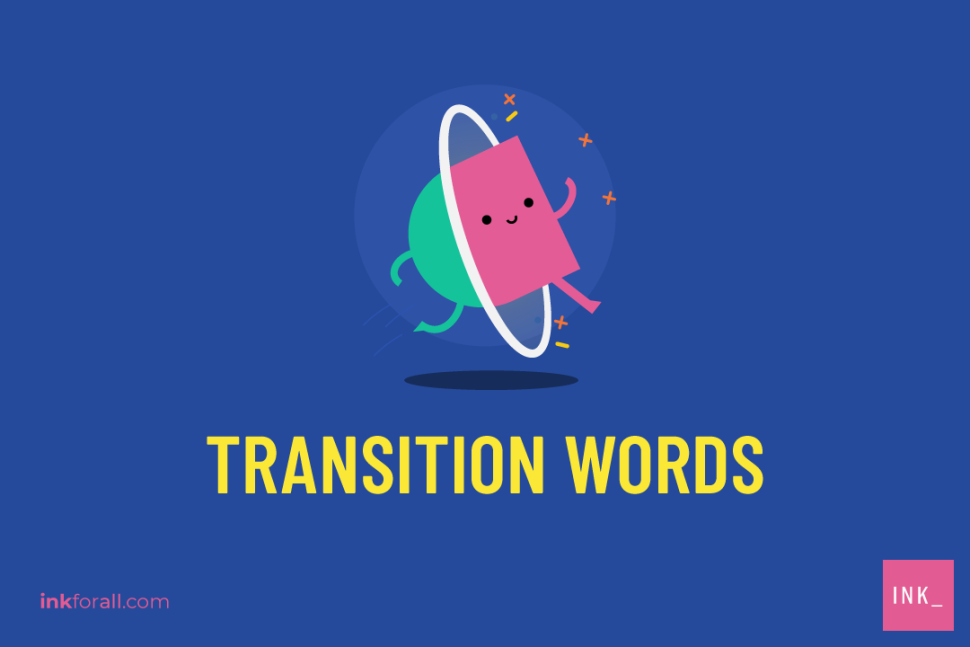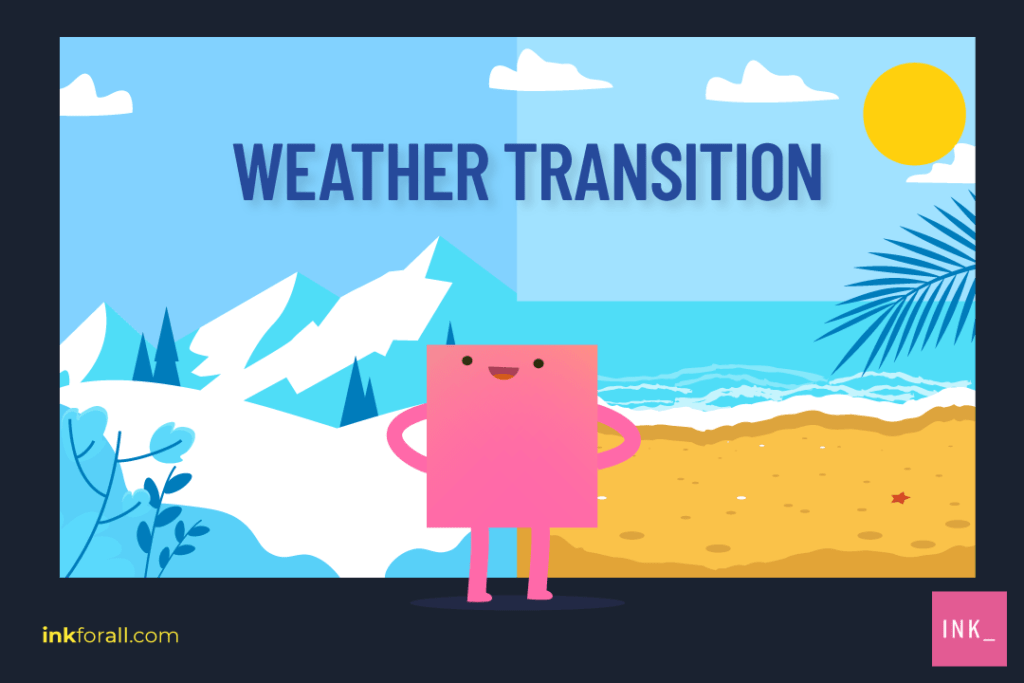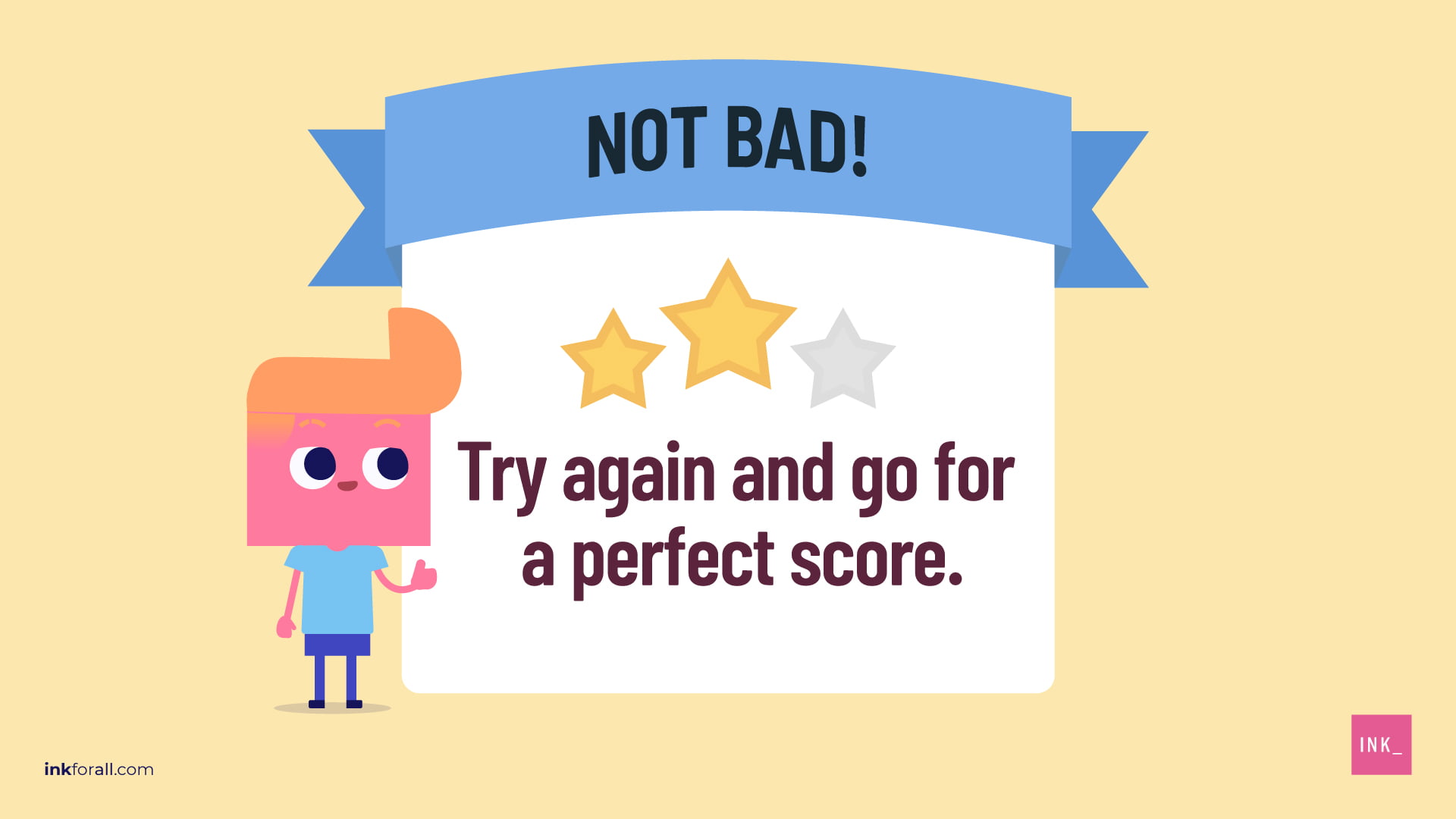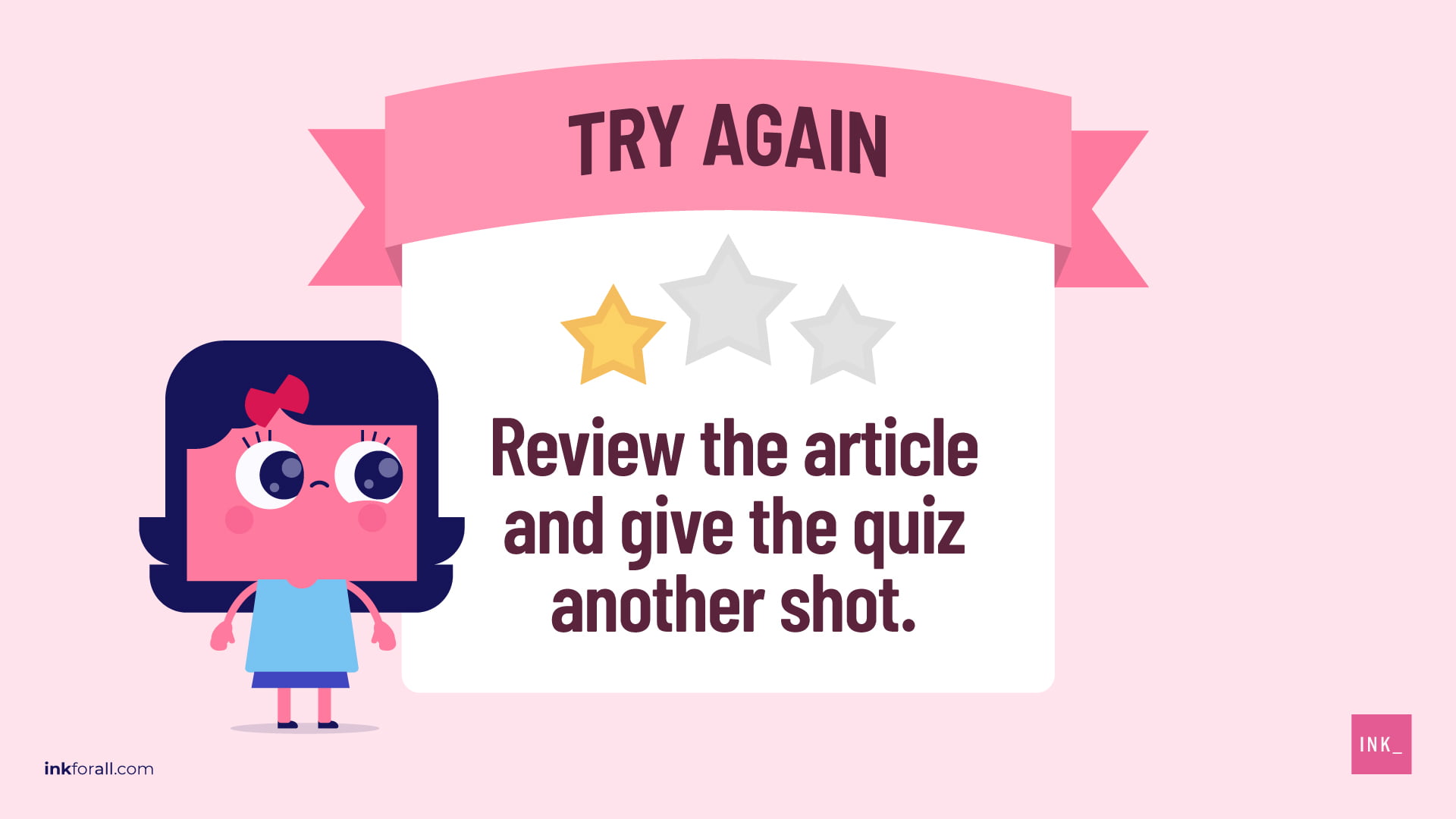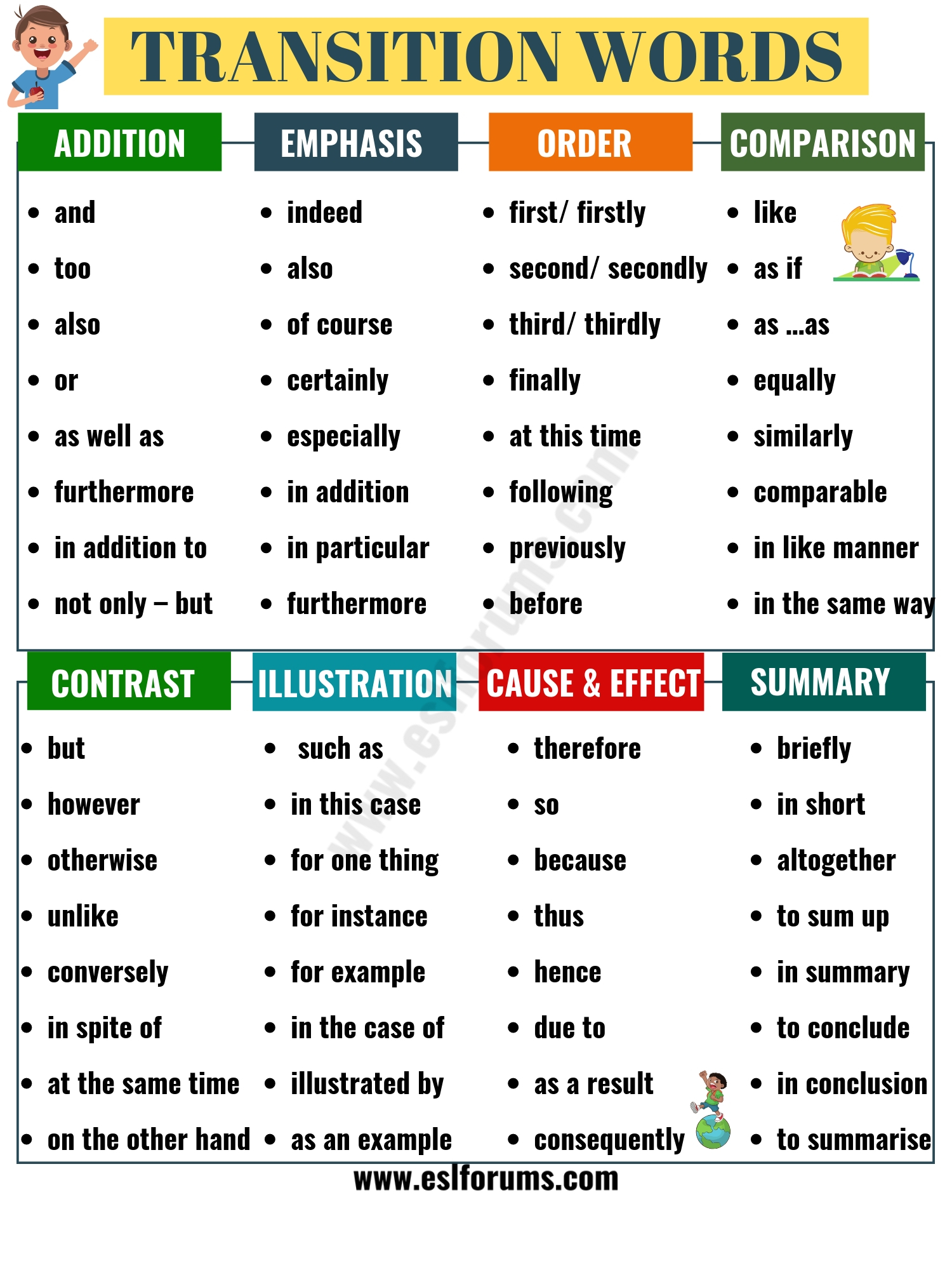Main Transition Words Takeaways:
- Transitional words are important because they help improve the flow between words, phrases, sentences, and paragraphs.
- They are important for SEO because they help make text easier to read and understand. Search engines and readers love content that is readable.
- Transition words help link ideas and statements.
- Using transitional words at the beginning or end of a paragraph can help the reader understand when you introduce a new topic.
- The four types of transition words are additive, adversative, causal, and sequential.
- Transition words and phrases don’t affect the grammatical structure of sentences and paragraphs.
What Are Transition Words?
As a writer, your primary goal is to present information and ideas to your target audience in a clear and understandable manner. The best way to do that is to use transition words. Transition words or transitional words are terms and phrases that help connect words, phrases, and even sentences together. They build connections between ideas in your content.
Transition words and phrases ensure that your written work will not look choppy and disjointed. They help your audience progress from one idea to the next. Think of them as a way to tell your readers how they should process and understand the information you are giving them. Transition words function like GPS, guiding your readers where they are going and how to get there.
What Are Some Examples Of Transition Words and Phrases?
Here are some of the most common examples of transition words and phrases:
Not to mention
Equally important
As a matter of fact
Not only/But Also
In addition
In fact
For example
What is more
In particular
On the other hand
When in fact
But even so
Whatever happens
In any case
Because of
Due to
In the event that
With this in mind
To conclude
By the way
To return to the subject
As has been mentioned
Given these points
Transition words are categorized based on their purpose. For instance, transition phrases like as a result of, due to, and as long as are used to emphasize cause and effect. Below are more examples of transition expressions that have been categorized based on their functions:
Cause and Effect
granted that
as long as
for the purpose of
in order to
in view of
as a result of
due to
because
therefore
consequently
so
accordingly
thus
hence
Since
for
owing to
as a consequence of
leads to
contributes of
stems from
comes from
results from
Evidence
as well as
and
too
also
in addition to
or
not only… but also
further
furthermore
besides
in addition
moreover
then
again
finally
by the same token
identically
uniquely
certainly
truly
including
to be sure
namely
chiefly
Contrast
however
on the other hand
otherwise
but
unlike
conversely
in spite of
at the same time
nevertheless
alternatively
on the contrary
yet
whereas
apart from
even so
although
while
Comparison
as
as if
similarly
equally
like
in the same way
comparable
as with
of contrast
despite this
in comparison
in contrast
even though
likewise
in like manner
Opinion
I feel
I believe
in my opinion
as fast as I know
in my experience
as for me, I think
if I’m not mistaken
I think
in my view
it seems likely
it seems to me
what I mean is
i’d say that
Similarity
moreover
as well as
together
of course
likewise
comparatively
correspondingly
similarly
furthermore
additionally
Clarification
that is to say
in other words
to clarify
that is
to explain
to put it another way
to rephrase it
in this case
I mean
up to a point
under certain circumstance
Sequence/ Order
first
second
next
finally
at this time
following
previously
before
prior to
before
Time
later
after
before
soon
meanwhile
during
subsequently
after that
at the present time
sooner or later
in due time
as long as
in the meantime
in a moment
at this instant
from time to time
Condition / Purpose
provided that
given that
in case
even if
only if
so as to
in as much as
when
whenever
if… then
unless
because of
as
while
lest
since
Emphasis
also
especially
furthermore
indeed
in addition
in particular
certainly
of course
significantly
notably
in fact
actually
in reality
as it happens
Conclusion
in conclusion
to conclude
finally
summarizing
overall
on the whole
to sum up
evidently
briefly
in short
altogether
in summary
to summarize
Place
here
there
over there
under
beyond
to the left
opposite
in the distance
Illustration
such as
in this case
for one thing
for example
in the case of
illustrated by
as an example
for instance
in other words
as revealed by
an instance
to show that
Reservation
admittedly
even so
as a matter of fact
indeed
nevertheless
even though
despite this
notwithstanding
regardless
What Are Some Examples of Transition Sentences?
The best way to understand how transitional words work is to see them in action. Remember, as important as these grammatical tools are, it’s not a good idea to overuse them. Too many transitional phrases can make your text seem complicated and wordy. It could also make you seem like a chronic overexplainer, and nobody wins when that happens.
You can use transitions to go from sentence to sentence:
You can also use transition words and phrases to go from paragraph to paragraph:
What Are the Four Types of Transition Words?
There are a lot of different ways to categorize transition words. In this post, we will discuss the four main types of transition words: Additive, Adversative, Causal, and Sequential.
1. What are Additive Transitions?
These transition words add or introduce another idea. They may also reference a previously mentioned concept, identify a similarity, or clarify an idea. Additive transitional words include:
2. What are Adversative Transitions?
Adversative transitions may be used to signal opposing ideas or dismiss a previously discussed idea altogether. Some adversative transition words include:
3. What are Causal Transitions?
As for causal transitions, they’re most commonly used to denote cause and effect. They may also indicate the reason an idea or action is happening or has happened. Causal transition words include:
4. What are Sequential Transitions?
As the name suggests, sequential transitions are used to put a sequence of ideas in order (usually chronological). This helps the reader understand where ideas fall in a list or when you’re wrapping up your text. Sequential transitions include:
Are Conjunctions Considered Transition Words?
While conjunctions and transitions share the same purpose — to connect ideas between or within sentences — they are not used the same way. You must not confuse conjunctions with transitional words or expressions. Conjunctions connect phrases and clauses, whereas transitions indicate the relationship between sentences and paragraphs. Check the following examples:
Subordinating conjunctions connecting dependent clauses with independent clauses:
Read More: The Easiest Way To Get Subordinating Conjunctions
Coordinating conjunctions connecting two independent clauses:
Transition words connecting sentences and paragraphs:
Another significant difference between transitions and conjunctions is their grammatical functions. Since conjunctions join clauses, they become part of the sentence and affect it grammatically. On the other hand, transition words have no impact on the grammatical structure of a sentence or paragraph. In short, you can remove a transition word, and it won’t have any impact on the sentence at all. Check the examples below:
Do Commas Go Before Or After Transition Words?
The placement of commas when using transition words will depend on where the latter appears in your text.
If your transition phrase appears at the beginning of the sentence, it is always set off with a comma.
If the transition word or phrase appears within an independent clause, it should be preceded by and set off with a comma.
If the transitional word appears between two independent clauses in a compound sentence, it should be preceded by a semicolon and set off with a comma.
How Are Transition Words Used in SEO?
SEO, or search engine optimization, is a process that involves optimizing your content for search engines to help improve ranking. The higher you are in search results, the more visibility your content will have. The more visible your content, the more people will see and learn about your brand.
Unlike keywords or meta tags, transitions between sentences or paragraphs don’t directly help boost your search ranking. Instead, it’s all about readability and structure.
See, Google runs on algorithms and those algorithms are big fans of order and ease of use. In other words, clarity is everything.
In the olden days (you know, like the 2010s), Google was like a heat-seeking missile for keywords. Basically, the more keywords you could stuff in your copy, the better you’d rank. That led to a lot of web pages that said something like, “buckets buckets buy some buckets buckets for sale the best buckets.”
What are they selling? You guessed it: buckets!
Google (and the rest of the world) soon realized the keyword stuffing wasn’t really good for anyone. Instead, search engines began focusing on how web pages could best serve the reader. Now, algorithms analyze web content for readability, and transition words play a huge role in that determination.
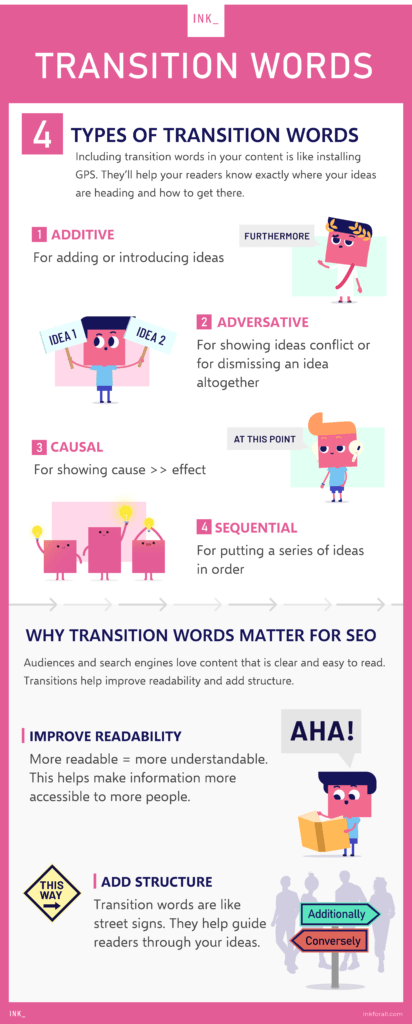
Transition Words Give Direction
Transition words also help you structure your content. Remember our road map? Transitional words can act as street signs, pointing readers left or right, directing them to take a U-turn, or propelling them onward.
Bottom line: Transition words make your content easier to read and understand. For this reason, it’s vital to rely not only on helpful tools but also on your own mind. If it reads well to you, it’ll likely read well to your audience.
Transition To a Closing
Finally, you can use transitions to introduce a new section or conclude your previous one—or wrap up the entire text. You may even use a transition to reinforce the general idea of your content before ending your piece:
Quick Transition Words Grammar Quiz
Transition Words Question #1
A. Causal
B. Additive
C. Adversative
D. Sequential
Correct!
Wrong!
The correct answer is letter C. Adversative transition words may be used to signal opposing ideas or dismiss a previously discussed idea altogether.
(E.g., but, however, conversely, still, and besides)
Causal Transition Question #2
A. Additionally
B. Consequently
C. Either way
D. To illustrate
Correct!
Wrong!
The correct answer is letter B. Consequently along with words like for, since, unless, as a result, and hence are all causal transition words.
(E.g., «Flexible workers often find themselves in great demand, and consequently, earn high wages.»)
Transition Words in SEO Question #3
A. They make content more interesting.
B. They make content easier to read.
C. They help increase word count.
D. Trick question! They’re not important for SEO at all.
Correct!
Wrong!
The correct answer is letter B. Transition words help improve the flow of ideas within a piece of content, making it more readable and easy to understand. Content with a high readability score can boost your SEO.
Transition Words Quiz Result
You’re an expert!
Not Bad!
Almost got it! Review the article and try again.
Read More: How to use a question mark (?)
Author: Michael L
Date: Oct 3, 2019 | Grammar
Transition words and phrases are an important part of the English language. They are used to connect words and sentences, often by referring back to one idea and signaling the introduction of a new one. Transition words can also help a passage of writing flow better, although it is best not to overuse them.
Consider the example:
- James did not go to the movies. He visited his grandparents instead.
The transition word in the above example is instead. It links the two sentences together by referring back to the first sentence and signaling that an alternative idea has been introduced.
Consider the example without the transition word:
- James did not go to the movies. He visited his grandparents.
The lack of a link between the two sentences leaves things a bit vague. We do not explicitly know that the two sentences are related, whereas the previous example shows that James visited his grandparents as an alternative to going to the movies.
There are 100s of transition words and phrases in English. Indeed, because of the evolution of language over time, new transition phrases can appear all the time. Often transition words are conjunctive adverbs – words like however, also, indeed, instead, still, therefore – or phrases containing conjunctive adverbs, conjunctions and adverbs. The point is that transition words cover a wide variety of language, but it’s more important to recognize their function rather than categorize them.
When to Use Transition Words?
Fundamentally, we use transition words to connect sentences and words together. They often refer back to the previous sentence or words within a sentence, and let the reader know that there is some related or new information on its way. There are different types of transition words and phrases, and not all of them have this simplistic explanation for their use.
Consider the passage below, and notice the highlighted transition words and phrases:
I do not like dairy products very much, particularly cheese. However, I make an exception for ice cream, especially chocolate ice cream. Indeed, ice cream is probably my favorite thing to eat. Admittedly, I am also aware that ice cream is very fattening, not to mention full of sugar. In other words, ice cream isn’t very healthy. Nevertheless, life is too short to worry about these things. With this in mind, I will continue to eat ice cream every day. I may end up overweight, of course. On balance, this is a price I am willing to pay for delicious – especially chocolate – ice cream.
Can you see how the transition words and phrases stitch the fabric of the passage together? They act as signals by referring to the previous sentence and introducing new ideas in the next, or by referring back to previous information in the same sentence and changing the emphasis of it. Normally, transition words and phrases help a passage of writing flow better, but it’s also recommended not to use too many transition words, as it can make the writing a bit confusing or heavy. As an example, the passage above arguably uses too many transitional words and phrases from a stylistic standpoint and would be easier to read with fewer transtions.
Types of Transition Words
As we mentioned, transition words are normally used to link words and sentences by referring back to one idea and introducing a new one. However, transition words do this in a variety of ways. With that in mind, let’s break down the different types of transition words into categories based on the way they link words together.
Here are some of the main ways transition words are used:
To introduce a new idea or opposite point of view:
- But, while, conversely, however, nevertheless, yet, instead, nonetheless, although, though, even though, incidentally.
- I went to his house hoping to find him; yet, he was not there.
- They told her they weren’t happy with her designs, but she nevertheless resolved to go on.
To introduce a conclusion:
- Finally, so, as, therefore, thus, consequently, in conclusion, since, as such, finally, subsequently.
- Finally, the choir began singing.
- Since that is the case, we have no choice but to resign.
To introduce a list or point out a sequence of events:
- First, second, third, firstly, secondly, first of all, last of all, finally, lastly, after that, until, including, next.
- We go to Paris this Sunday. After that, Rome.
- First of all, let me tell you what happened. Then you can decide.
To admit a concession:
- Of course, admittedly, even so, naturally, alas.
- There is another way to do it, of course.
- Admittedly, it was my biggest mistake.
To add emphasis or additions.
- Likewise, in addition, furthermore, also, additionally, moreover, indeed, namely, in fact, for the most part, as a matter of fact.
- David, Benjamin and Ellie laughed. Indeed, even Daniel found it funny.
- For the most part, the kids in the classroom kept quiet.
To introduce clauses and conditions:
- On the condition that, in light of, in order to, provided that, whenever, while, as long as.
- You can go, as long as you are back by midnight.
- Whenever you return, lock the door after you.
The above just shows a small selection of different transition words and phrases, but there are many more words and phrases used in this way. It can also be somewhat confusing, because sometimes the words on the list above can be used in a sentence without it being a transition word.
Consider these two sentences:
- Despite nerves, Donna came first in the race. (First is not a transition word in this sentence.)
- To win a race, first you must believe you can win. (First is a transition word in this sentence.)
Examples of Transition Words
Below are some more examples of transition words in sentences:
- The Queen is the UK’s Head of State. Additionally, she is also the Head of State for Australia.
- We were hungry. However, because the kitchen was already closed, we didn’t eat until morning.
- One doesn’t need to attend college. There are, in fact, many ways to obtain knowledge.
- She was very tired. Indeed, she hadn’t slept for weeks.
- In light of recent weather events, the show will be cancelled.
- Finally, the car came to a skidding halt.
- You should go to the conference. Likewise, Bill and Caren should go too.
- It’s obvious you don’t want me here. As a result, I have decided I will leave tomorrow.
- We are German citizens. But we are also citizens of Europe.
- He lowered his voice, as if to underline the seriousness of the matter.
- Monkeys groom each other in order to build relationships.
- Michael and Sarah are here. I was chatting with them earlier, as a matter of fact.
Why are Transition Words Important?
Without transition words and phrases, language would be somewhat stiff. They sew words and sentences together, helping them flow better by acting as a link to what was previously stated in the passage. Yet, they are more than that, they act as signals in writing to show shifts in ideas, tone and emphasis, and introduce conclusions, sequences and contradictions.
The key to understanding them lies in the name itself: Transition words. Transition means change, and these words indicate that there has been a change or that a change is forthcoming. This change could be subtle, like a shift in emphasis, or more obvious, like the offering of a contrary idea or conclusion, but transition words, nevertheless, act as a signal for that change. In the end, this is important because it gets to the root of how we understand language, as these transition words act like bridges through words, sentences and meaning.
Join our mailing list to not miss any Ginger communications and writing tips
You have been successfully subscribed to our blog
Transition sentences are an essential part of writing. They help the reader know what information is coming next and show how it relates to the previous sentence.
The best transitions will be clear, brief, and easy for the reader to understand. There are many different kinds of transition words and phrases writers use depending on the context.
Defining Transitional Words and Phrases
Transitional words and phrases are words and phrases that carry meaning from one sentence to the next. They can help express time, writing technique, or logic.
Writers use these words to make their sentences cohesive and help the reader quickly grasp the sentence’s meaning.
Some common transitional words are:
• However
• Furthermore
• Nevertheless
• Despite
• Consequently
Transition phrases are also common. They can connect ideas or clauses within a sentence. Some common transitional phrases are:
• As a result
• In spite of
• On the other hand
Types of Transition Words and Phrases
Time Transitions
Time transitions help the reader know whether a sentence is about the past, present, or future.
Here are some examples of common time transitions:
- After
- Before
- Ever since
- Immediately
- Finally
- Just recently
- Meanwhile
- Momentarily
- Now
- Soon after
- Until then
- Up until now
- While
Writers should also consider using time transitions to show cause and effect.
Sentence example:
She got up, grabbed her phone, and left the room.
She got up and grabbed her phone. Afterward, she left the room.
The second sentence has a more coherent flow, as the cause and effect are clear.
Logical Transitions
Logical transitions show how one sentence relates logically to the next.
Here are some examples of logical transitions:
• As a result
• Due to
• Therefore
• Since
• In contrast to
• Despite
• In other words
• Conversely
• As such
• Consequently
• Hence
Sentence examples:
Walking to the park takes longer than driving. Therefore, people are less likely to walk.
In this sentence, ‘therefore’ is a logical transition because it shows the link between one action and its effect.
Logical transitions can show a cause-and-effect relationship as well.
Sentence example:
The computer crashed since someone left it on overnight.
The computer crashed as a result of being on for a long period.
The second sentence is more cohesive and will make more sense to the reader.
Driving to the park takes less time. As such, people are more likely to drive.
Here, ‘as such’ is a logical transition because it shows what will come next. This sentence continues the same logic as the first sentence.
Cause and effect transitions
These transition words help show how two or more sentences are related. Typically, it is used to show the cause or effect of something. These include:
• Therefore
• So
• Since
• As a result
• Due to
• Hence
Sentence example:
A higher price leads to fewer sales. As a result, the store is going out of business.
In this case, “A higher price” is the cause, and “fewer sales” is the effect.
Another example:
John was very busy at work, and he didn’t have time for a party.
As a result, no one invited him to anything.
In this case, “John was very busy at work” is the cause, and “no one invited him to anything” is the effect.
Transition phrases can also be clarifying.
Sentence example:
After the meeting was over, Susan left the office.
Susan left the office after the meeting was over.
The second sentence is more coherent and flows better than the first sentence.
Clarifying transitions
These transitions bring clarifications to the sentence. By using clarifying transition words and phrases, the writer makes sure that the information is clear and cohesive. Some clarifying transitions are:
• In other words
• In brief
• In essence
Sentence examples:
The story of Cinderella is a new take on an old tale.
In other words, the writer rewrote an old story with a new plot and characters.
The second sentence is more coherent.
She got up and left the room.
Afterward, she grabbed her phone and left.
The first sentence doesn’t tell when she left the room, so it can sound confusing.
The clarifying transition in the second sentence makes sure that the reader knows when she left the room.
Formality Transitions
When writing formally, writers need to use formal words to create clear sentences. Some examples of formal transitional words and phrases are:
• At any rate
• In a sense
• In effect
• In other words
• In particular
• Instead
• Meanwhile
• To illustrate
Sentence example:
In effect, the rain stopped us from going outside.
It rained, and it stopped us from going outside.
The first sentence is more formal than the second sentence.
Compare and contrast transitions
These transitional words and phrases show how two or more things are alike or different. Compare, and contrast transitions include:
• In comparison with
• On the other hand
• Alternatively
• Despite this
• Conversely
• In contrast to
A comparison example:
John is a fast runner. However, he can’t run a marathon.
In this case, “fast runner” and “can’t run a marathon” are compared.
An example of contrasting words:
John is a fast runner, but Bill is a slow runner.
In this case, “John is a fast runner” and “Bill is a slow runner” are contrasted. This example shows that John is fast while Bill is slow.
Sequence transitions
Sequence transitions show how two or more things are related in terms of time, logic, cause/effect, etc. Some sequence words and phrases are:
• First
• Later on
• Meanwhile
• Afterward
• Finally
• Prior to this/that/etc
Sentence example:
First, John applied for a job at a cafe.
Then, he got an interview.
In this case, “First” is the transitional phrase, showing the sequence of events.
Addition transitions
Addition transitions add more information to the sentence. They can be used before or after a sentence. Examples of such transitions are furthermore and moreover.
Sentence example:
It was a very cold day. Moreover, it started to snow.
In this case, “Moreover” is the transitional word, adding more information to the cold day.
Concluding transitions
Concluding transitions signal the end of a sentence. These transitional phrases and words show that the writer’s idea has been fully expressed. Concluding transitions include:
• To conclude
• At the end of the day
• Finally
• In short
• To summarize
• All in all
Sentence example:
Having said that, it is worth noting that not everyone thinks the same way.
In this case, “Having said that” is the transitional phrase, and it signals that the writer’s idea has been fully expressed.
Grouping transitions
These transitions group similar ideas. Some grouping examples are:
• On one hand
• On the other hand
• Or else/or otherwise
• In other words
Sentence example:
John likes to play tennis, but he also enjoys skiing.
In this case, playing tennis and enjoying skiing are similar ideas. The grouping transition “but also” groups them together.
Delaying transitions
A delaying transition delays the main idea in a sentence. These transitions are often used to create suspense and interest right before stating the main idea.
Sentence example:
Although he lost three games, he won the first set.
In this case, the writer wants to start with “He lost three games” but instead delays it until later in the sentence.
Writing Technique Transitions
These transitional phrases and words help writers to focus on specific points. They can be used whenever a writer wants to increase the importance of a sentence. Some examples of such transitions are:
• First and foremost
• In addition
• At the same time
• Likewise
Sentence example:
First and foremost, it is important to note that the company was established in 2007.
In this case, “First and foremost” is the transitional phrase, increasing the importance of the sentence.
Transitional Sentences
Transitional sentences are a great way to show how sentences relate to one another. A transitional sentence will help a writer with their flow and allow the reader to comprehend what they are reading more easily.
Here is an example:
Her phone rang, so she picked it up.
She put down her book and answered the phone. As a result, she found out that her date was going to be a half-hour late.
In the first sentence, the phone rings, and she answers it. The second sentence explains how she found out her date was going to be late.
A transition within a paragraph is used to show the reader how each idea is related. This will help them understand the logic of what you are saying.
His friends took him out to celebrate his upcoming birthday.
First, they went to a local sports bar where he had pizza and wings. Afterward, they went to a local nightclub where they danced the night away.
The first sentence explains that his friends are taking him out to celebrate his birthday. The second sentence explains what they did during the celebration.
A transition to the next idea is used for longer texts. It can be used in essays, articles, novels, textbooks, and many other places. This transition shows the reader how to move from one idea to the next.
When transiting to the next paragraph, it is important to show the reader where the transition is. This will help them start on the right foot in your next argument or idea.
That day, he went to class and talked about the assignment. Meanwhile, his friends were talking about where they were going for their next vacation.
In the first sentence, he is talking about his assignment in class. In the second sentence, he is talking about where his friends are going on vacation.
These transitions will help the reader understand how each new section is different from the one before it. They can be used in many different types of writing and are helpful for all audiences.
When moving from one section to the next, it’s easy to lose the reader. Using transitional words will help them understand what is changing and how each section is different from the last.
When she got home, she sat down and turned on the television.
However, after watching two hours’ worth of reality TV shows, she decided to go to bed.
In the first sentence, she is watching TV at home. In the second sentence, she decides that it is time for bed.
Transitions make writing more cohesive and easier to understand. Transitional words and phrases connect ideas while showing the direction in which you are going. This makes transition sentences easy for readers to follow and gives your work a sense of organization that will help them get the information they need quickly.
Your essay takes shape following these two elements: The order and the relationships of ideas.
Order: The way you arrange your ideas and concepts is essential when dealing with essays transition words. There should be order as you move from one paragraph to the other.
As you transit to the new paragraph, you’re also establishing new relationships. Transitions should mirror the order you want to establish between your ideas and concepts.
Your readers will understand the order in your essays if you do these two things:
In a travel essay, you might begin in one paragraph by describing the sights of a faraway country. The second paragraph should address your stay in the place. In a third, you would conclude by describing the culture shock of returning home. Each paragraph builds on what came before it and leads to the next.
Relationships: Because transitions establish relationships between ideas, they can be used to combine or contrast them. This transitional element allows you to show the different ways it is possible to consider a subject.
As you transit from one section to the other, remember the previous paragraph is equally important as the next. This consideration makes it easier to determine relationships.
Readers can only see the relationships in your ideas if you do these three things:
Transition sentences are very helpful. They can help the reader understand what you are saying and how your ideas relate to one another. There are many different types of transition words/sentences to use.
Making sure that your texts have a logical flow will make the reader more interested in what you are saying.
As a “part of speech” transition words are used to link words, phrases or sentences. They help the reader to progress from one idea (expressed by the author) to the next idea. Thus, they help to build up coherent relationships within the text. In this lesson, you will learn a list of useful transition words and phrases in English.
Transition Words of Addition
List of transition words of addition.
- As well as
- And
- Too
- Furthermore
- Also
- In addition to
- Not only – but also
- Or
- And
- In addition to
- Furthermore
- Moreover
- Besides
- Than
- Too
- Also
- Both-and
- Another
- Equally important
- First
- Second
- Again
- Further
- As well as
- In the second place
- Next, likewise
- Similarly
- For example
- For instance
- However
Transition words of addition with examples
- As well as
He plays classical music, as well as pop and jazz.
- And
There is no paradise on earth equal to the union of love and innocence
- Too
‘Nice to talk to you.’–‘Nice to talk to you too.’.
- Furthermore
He is lazy, and furthermore, he has no sense of responsibility.
- Also
The rehearsal process also irked him increasingly.
- In addition to
The film star has an incredible car in addition to a large house.
- Not only – but also
We do not only meet to share each other’s burdens but also to partake in each other’s joys.
- Or
Music has charms to soothe a savage breast, to soften rocks or bend a knotted oak.
Transition Words of Illustration
List of transition words of illustration.
- Thus
- For example
- For instance
- Namely
- To illustrate
- In other words
- In particular
- Specifically
- Such as
- In this case
- For one thing
- In the case of
- Illustrated by
Transition words of illustration with examples.
- Such as
America wants to eliminate tariffs on items such as electronics.
- In this case
In this case, several solutions could be tried.
- For one thing
For one thing, intelligence does have some impact on foreign policy, for example, towards rogue states.
- For instance
Murder, petty theft and tax evasion, for instance, all have different motives and consequences.
- For example
There is a similar word in many languages, for example in French and Italian.
- In the case of
In the case of the car industry, in the case of Ford, it’s even higher.
- Illustrated by
The difference is best illustrated by a case example.
- As an example
It is given only as an example which is easy to state.
Transition Words of Cause and Effect
List of cause and effect transition words.
- Consequently
- Therefore
- So
- Because
- Thus
- Hence
- Due to
- As a result
Cause and effect transition words with examples.
- Therefore
He has broken his leg and therefore he can’t walk.
- So
Places are strictly limited, so you should apply as soon as possible.
- Because
Because friendships enhance our lives, it is important to cultivate them.
- Thus
He didn’t work hard. Thus he was fired.
- Hence
Cocaine production requires large amounts of water, hence factories are nearly always built by streams.
- Due to
The country economic problems are largely due to the weakness of the recovery.
- As a result
As a result, he went bankrupt soon.
- Consequently
My car broke down and consequently I was late.
Transition Words of Comparison
List of comparison transition words.
- Similarly
- Likewise
- In like fashion
- In like manner
- Analogous to
- As …as
- As if
- Equally
- Similarly
- Like
- In the same way
Comparison transition words with examples
- As …as
He is as tall as his brother.
- As if
Since his cancer was diagnosed, he feels as if he’s living on borrowed time.
- Equally
False humility and its obverse, arrogance, are equally unpleasant.
- Similarly
Similarly, Fire Support Company had to set up their display of mortars, anti-tank missiles and Scimitar tracked recce vehicles.
- Like
Benefits please like flowers, while they are fresh
- In the same way
We like them in the same way that we like pretty curtain material.
- Comparable
Its brain is closely comparable to the brain of a chimpanzee.
- In like manner
And in like manner buyers will fence, and pretend to be less eager than they really are.
Transition Words of Contrast
List of contrast transition words
- On the contrary
- Contrarily
- Notwithstanding
- But
- However
- Nevertheless
- In spite of
- In contrast
- Yet
- On the one hand
- On the other hand
- Rather
- Or
- Nor
- Conversely
- At the same time
- While this may be true
Contrast transition words with examples
- But
Weak men wait for opportunity, but the strong men make it.
- However
The ant is the most industrious animal; however, it is the most taciturn one.
- On the other hand
I want to go to the party, on the other hand, I ought to be studying.
- Otherwise
Shut the window, otherwise, it’ll get too cold in here.
- Unlike
Dan’s actually quite nice, unlike his father.
- Conversely
In real life, nobody was all bad, nor, conversely, all good.
- At the same time
I was afraid of her, but at the same time, I really liked her.
- In spite of
In spite of my efforts, the boy remained passive.
Transition Words of Emphasis
List of transition words of emphasis
- Above all
- Indeed
- Truly
- Of course
- Certainly
- Surely
- In fact
- Really
- In truth
- Again
- Besides
- Also
- Furthermore
- In addition
Transition words of emphasis with examples
- Especially
Divorce is very painful, especially when children are concerned.
- Also
The study also demonstrated a direct link between obesity and mortality.
- In particular
The military, in particular, were subjected to intense political indoctrination.
- Furthermore
He is old and unpopular. Furthermore, he has at best only two years of political life ahead of him.
- In addition
The company provides cheap Internet access. In addition, it makes shareware freely available.
- Indeed
This was indeed the most memorable day of my life.
- Of course
In any of these discussions, of course, honesty is of the essence.
- Certainly
There certainly wasn’t any malice in her comments.
Transition Words of Order
List of transition words of order
- First/ firstly
- Second/ secondly
- Third/ thirdly
- Finally
- At that time
- Previously
- Before
List of transition words of order with examples
- First/ firstly
Firstly, they must make certain that their pension needs are adequately catered for.
- Second/ secondly
Firstly, it’s expensive, and secondly, it’s too slow.
- Third/ thirdly
Thirdly, they tend to see human behaviour as shaped by the system.
- Finally
I kept at it and finally finished at 3 o’clock in the morning
- At that time
At that time, it was completely unheard-of for girls to go to university.
- Previously
A number of trades, previously thought of as lowly ones, began to receive more attention.
- Before
He snatched the photos out of my hand before I had a chance to look at them.
Transition Words of Summary/ Conclusion
List of transition words of conclusion
- In conclusion
- To summarise
- Altogether
- In short
- To sum up
- Briefly
- To conclude
- Therefore
- Finally
- Consequently
- Thus
- In short
- In conclusion
- In brief
- As a result
- Accordingly
Transition words of conclusion with examples
- In conclusion
In conclusion, walking is a cheap, safe, enjoyable, and readily available form of exercise.
- To summarise
To summarise, this is a clever approach to a common problem.
- Altogether
Altogether, our achievements are very great.
- In short
Try tennis, badminton or windsurfing. In short, anything challenging.
- To sum up
Well, to sum up, what is the message that you are trying to get across?
- In summary
In summary, all government departments are administered rather differently.
- Briefly
Briefly, the hunter and his quarry glared at each other.
- To conclude
To conclude, I’d like to express my thanks to my family.
Transition Words of Time & Sequence
List of transition words of time & sequence
- Later
- After
- Before
- Then
- Soon
- Finally
- First, second…
List of transition words of time & sequence with examples
- Later
Later, it transpired she had failed the examination.
- After
It is not enough to help the feeble up but to support him after.
- Before
Before you give up, think of the reason why you held on so long.
- Then
If you doubt yourself, then indeed you stand on shaky11 ground.
- Soon
Always taking out the meal-tub, and never putting in, soon comes to the bottom.
- Finally
Finally, he returned to the official line from which he had swerved.
- First, second…
First, catch your hare then cook him.
Transition Words of Direction & Place
List of transition words of direction & place
- Here
- Over there
- Beyond
- Under
- To the left
- In the distance
- Opposite
List of transition words of direction & place with examples
- Here is a summary of the news/a news summary.
- Are they friends of yours, over there?
Transition Words and Phrases | Infographic
One of your primary goals as a writer is to present ideas in a clear and understandable way. To help readers move through your complex ideas, you want to be intentional about how you structure your paper as a whole as well as how you form the individual paragraphs that comprise it. In order to think through the challenges of presenting your ideas articulately, logically, and in ways that seem natural to your readers, check out some of these resources: Developing a Thesis Statement, Paragraphing, and Developing Strategic Transitions: Writing that Establishes Relationships and Connections Between Ideas.
While clear writing is mostly achieved through the deliberate sequencing of your ideas across your entire paper, you can guide readers through the connections you’re making by using transitional words in individual sentences. Transitional words and phrases can create powerful links between your ideas and can help your reader understand your paper’s logic.
In what follows, we’ve included a list of frequently used transitional words and phrases that can help you establish how your various ideas relate to each other. We’ve divided these words and phrases into categories based on the common kinds of relationships writers establish between ideas.
Two recommendations:
Use these transitions strategically by making sure that the word or phrase you’re choosing matches the logic of the relationship you’re emphasizing or the connection you’re making. All of these words and phrases have different meanings, nuances, and connotations, so before using a particular transitional word in your paper, be sure you understand its meaning and usage completely, and be sure that it’s the right match for your paper’s logic.
Use these transitional words and phrases sparingly because if you use too many of them, your readers might feel like you are overexplaining connections that are already clear.
Categories of Transition Words and Phrases
Transitions to help establish some of the most common kinds of relationships
Causation–Connecting instigator(s) to consequence(s).
accordingly
as a result
and so
because
consequently
for that reason
hence
on account of
since
therefore
thus
Chronology–Connecting what issues in regard to when they occur.
after
afterwards
always
at length
during
earlier
following
immediately
in the meantime
later
never
next
now
once
simultaneously
so far
sometimes
soon
subsequently
then
this time
until now
when
whenever
while
Combinations
Lists–Connecting numerous events.
Part/Whole–Connecting numerous elements that make up something bigger.
additionally
again
also
and, or, not
as a result
besides
even more
finally
first, firstly
further
furthermore
in addition
in the first place
in the second place
last, lastly
moreover
next
second, secondly, etc.
too
Contrast–Connecting two things by focusing on their differences.
after all
although
and yet
at the same time
but
despite
however
in contrast
nevertheless
nonetheless
notwithstanding
on the contrary
on the other hand
otherwise
though
yet
Example–Connecting a general idea to a particular instance of this idea.
as an illustration
e.g., (from a Latin abbreviation for “for example”)
for example
for instance
specifically
that is
to demonstrate
to illustrate
Importance–Connecting what is critical to what is more inconsequential.
chiefly
critically
foundationally
most importantly
of less importance
primarily
Location–Connecting elements according to where they are placed in relationship to each other.
above
adjacent to
below
beyond
centrally
here
nearby
neighboring on
opposite to
peripherally
there
wherever
Similarity–Connecting to things by suggesting that they are in some way alike.
by the same token
in like manner
in similar fashion
here
in the same way
likewise
wherever
Other kinds of transitional words and phrases
Clarification
i.e., (from a Latin abbreviation for “that is”)
in other words
that is
that is to say
to clarify
to explain
to put it another way
to rephrase it
Intensification
in fact
indeed
no
of course
surely
to repeat
undoubtedly
without doubt
yes
Purpose
for this purpose
in order that
so that
to that end
to this end

